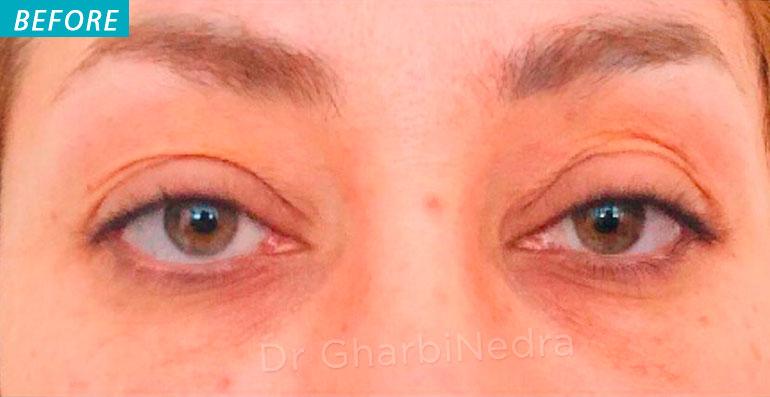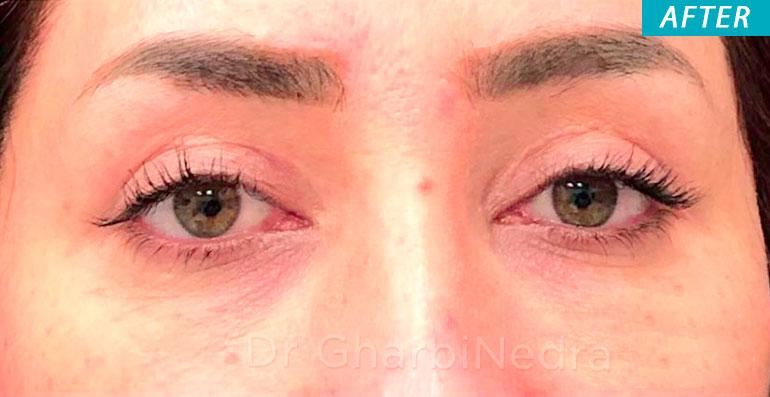‘Blepharoplasties’ means aesthetic surgical procedures of the eyelids aiming to correct unsightly aspects, whether due to heredity or age. They can be performed on the upper or lower eyelids alone, or all four at the same time.
This technique may be carried out alone or in association with other cosmetic facial surgery (brow-lift, forehead-lift, face- and neck-lift) or with techniques such as laser resurfacin,
The goal of a blepharoplasty is to correct signs of aging and remove the tired look due to the heavy eyelids by a more rested, relaxed appearance.
Drooping heavy upper eyelids, with a more or less marked skin-fold.
Lower eyelids which have drooped and shrunk, leading to horizontal wrinkles due to distended skin.
Bulging fat, responsible for ‘bags under the eyes’ at the lower eyelid level, or sagging upper eyelids
The procedure aims to correct these problems durably by surgical removal of excess skin, fat and muscle, without of course affecting the normal functions of the eyelids.
It should be noted that other age-related problems may be present but their treatment necessitates techniques more complex than standard blepharoplasty, or requires supplementary surgery.
This procedure, for both men and women, is often carried out around the age of forty.
It can however be done much earlier where the problem is congenital rather than age-related, for example in the case of bags under the eyes.
• BEFORE THE OPERATION
Prior to the operation a thorough examination of the eyes and eyelids will have been carried out in order to detect any anomalies which could complicate the procedure or indeed show that it is not recommended in this specific case.
A specialised ophthalmologic examination will often be prescribed to rule out any ocular pathology.
A preoperative check up will be carried out as prescribed.
An anesthesiologist will see you in consultation at the latest 48 hours before the operation.
No aspirin-based medication should be taken during the 10 days preceding the operation.
For certain types of anesthesia you may be required to fast (neither eat nor drink) for six hours before the operation.
• HOSPITAL STAY AND TYPE OF ANESTHESIA
Type of anesthesia
Three possibilities exist :
•
Local anesthesia alone, in this case the eyelids are numbed by an injection given locally.
•
Local anesthesia with sedation given by intravenous drip.(‘twilight’ anesthesia)
•
Standard general anesthesia, you sleep throughout the procedure.
The type of anesthesia will be chosen after discussion between yourself, the surgeon and the anesthesiologist.
Hospital stay
The procedure may be carried out on an out-patient basis, in an ambulatory facility, the patient leaves on the same day after a few hours under observation.
However, in some cases a short hospital stay can be preferable. The patient arrives in the morning (or sometimes the previous evening) and is discharged the following morning.
• THE PROCEDURE
Each surgeon has adopted his or her own specific technique which he or she adapts in order to obtain the best results in each case.
We can however give some basic points.

Incisions :
-Upper eyelids : They are concealed in the fold situated at the mid-point of the eyelid, between the mobile and fixed parts.
-Lower eyelids : They are 1 to 2mm below the eyelashes, and can go slightly beyond them.
Note : For the lower eyelids, in the case of isolated “bags” (without excess skin to be removed), a blepharoplasty can be carried out by the transconjunctival approach, that is by using incisions placed inside the eyelids, thus leaving no visible scar.
Resection : Once the incision made, unsightly excess fat is removed, as are redundant muscle and sagging skin. At this stage, numerous appropriate adjustments can be made in order to tailor the procedure to the specific needs of the patient.
Sutures : Stitches are made using very fine absorbable thread .
The operation can take between 30 minutes and 2 hours depending on the specific requirements and complexity of the case.
• AFTER THE OPERATION
There is no actual pain, but possibly some discomfort with a sensation of tension in the eyelids, slight irritation of the eyes and perhaps some blurring of vision.
During the first few days rest is advised, with no physical strain, no lifting heavy weights for example.
During the recovery period there will be edema (swelling), and bruising, to a variable degree for each individual patient.
For the first few days it may be impossible to close the eyes completely, a slight detachment of the external angle of the eye may also be observed, but in both cases these signs are rapidly reversible.
The scars may remain as pinkish lines for the first few weeks, but can be hidden by makeup from the 7th day onward.
• THE RESULT
The final aspect will not be visible before 3 to 6 months. This is the time lapse necessary for the tissues to regain their softness and for the scars to heal and practically disappear.
• POSSIBLE COMPLICATIONS
A blepharoplasty, although essentially an aesthetic procedure, is nevertheless an operation, and this implies that the risks inherent to any surgery apply here.
We must distinguish here between risks related to the anesthesia and those related to the surgery.
•
Concerning surgery : by choosing a competent, qualified Plastic Surgeon, used to performing this procedure, you limit the risks, without however eliminating them completely.
Fortunately, real complications are rare following a blepharoplasty which has been carried out correctly. In fact practically all the operations go well and patients are completely satisfied with the result.







